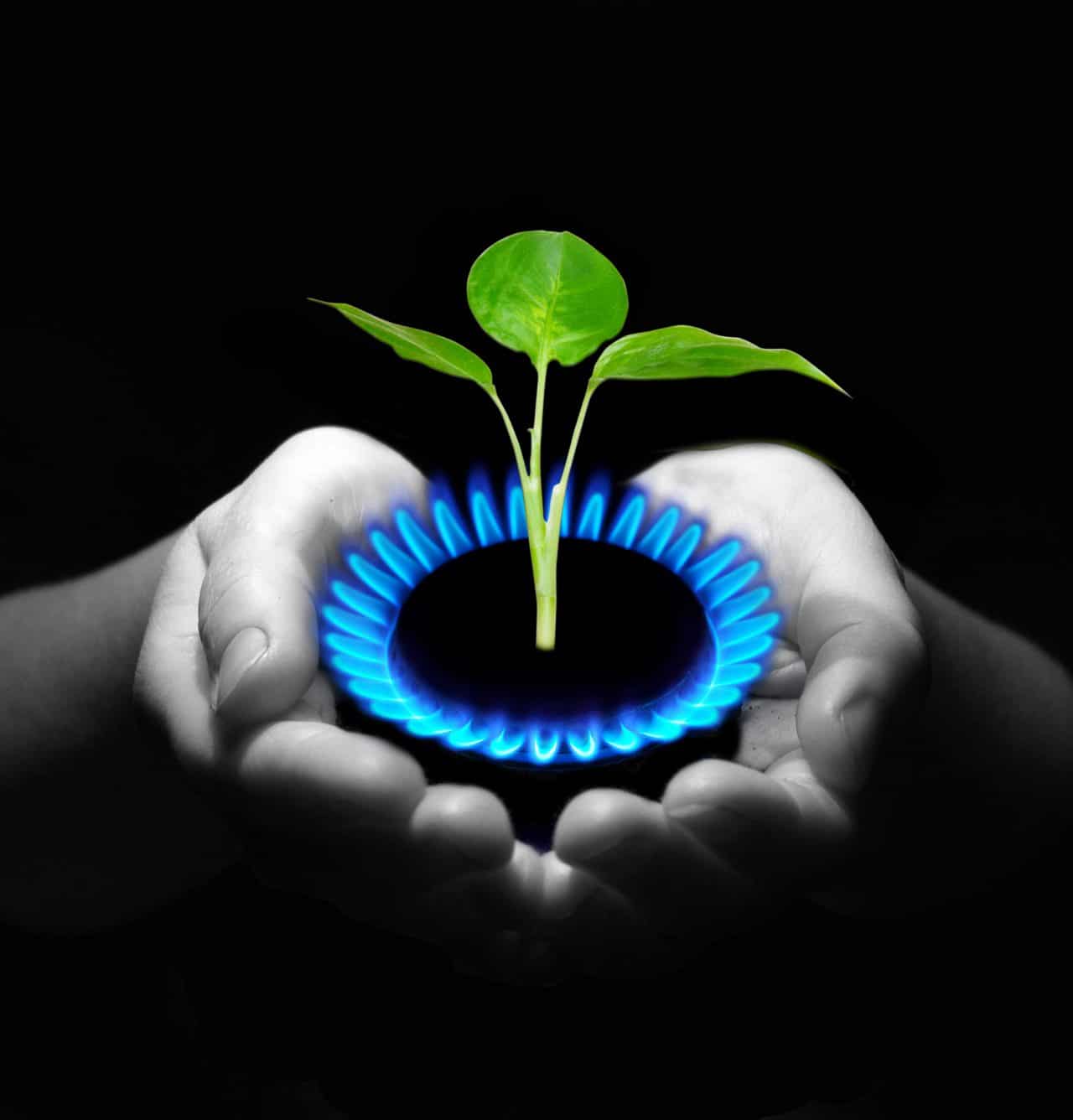Background on Natural Gas
Millions of years ago, plants, animals and microscopic organisms lived in the shallow, salty waters of Earth’s ocean. These creatures died and were buried under layers of sand, clay and silt. With the magic combination of heat, time and pressure, their remains transformed into three fossil fuels known today as coal, oil and natural gas.
Of these three fossil fuels, natural gas is considered the cleanest. It is odorless, colorless and shapeless. Natural gas is primarily composed of methane, which is identified by a four-hydrogen-single-carbon structure. Other compounds, such as ethane, propane and butane, make up a minimal portion of natural gas. A cleaning process removes hydrocarbons, water and carbon dioxide, purifying natural gas to be used in numerous ways throughout the modern world today.
History of Natural Gas
The Chinese first used natural gas to separate salt from ocean water and obtain drinkable water in 500 B.C. Manufactured natural gas was used for gas lights in Britain and America in the late 18th and early 19th centuries. However, the first manmade well with the intention of extracting non-manufactured natural gas came in 1821 with William Hart and the birth of the natural gas industry in Fredonia, New York. This natural gas was primarily used for light. Natural gas began to be used for cooking and heating with Robert Bunsen’s invention of the Bunsen burner in 1885.
Newly developed technologies after WWII enabled natural gas to be transported even more safely and efficiently, paving the way for natural gas to be used as it is today. Natural gas fuels our everyday lives by heating homes, fueling large scale industries and enabling household items such as ovens and water heaters to operate. The electricity used to charge a phone, listen to music or blow-dry hair comes from natural gas. Natural gas itself is invisible, but its impact is witnessed every day.
Modern Day Uses of Natural Gas
In the United States, nearly 29% of the total energy supply depends on natural gas. Consumption of this natural gas is split between industrial, electric and residential/commercial sectors with only a minor amount – as little as 3% – being used for transportation. (The gas used to fuel most automobiles comes from crude oil, not natural gas).
Industrial sectors use natural gas as a heat source to facilitate the production of everyday materials, including plastic and glass. It can also be used as a raw material in fabrics, fertilizers and various chemical compounds. Residential/commercial sectors primarily use natural gas for heating and lighting. Recent years have tracked an increase in using natural gas for cooling and cooking as well. Electric sectors use natural gas to generate 33% of the nation’s electricity. The only fuel that generates more electricity is coal.
The United States produces the most natural gas worldwide. Today, there are natural gas companies located in every state. Some of the largest natural gas companies include EQT/Rice, ExxonMobil, Chesapeake Energy and Southwestern Energy Company. Natural gas wells are located both on and offshore, with Texas and Pennsylvania being the highest natural gas producing states. Between geoscientists, extractors, safety managers, distributors and more, the natural gas industry is responsible for employing millions of individuals.
Pros of Natural Gas

Humans have been using natural gas for over 150 years because it is a natural resource with many uses. To understand the modern-day debate around natural gas, it is important to consider the advantages of its use.
-Emissions
One of the loudest environmental issues today is changes in climate related to the concentration of greenhouse gases, such as carbon dioxide, in the atmosphere. When compared to oil and coal, natural gas emits the lowest levels of carbon dioxide when burned. It emits 45% less than coal and 30% less than oil. It also releases a lower level of air particulates because byproducts are in a gaseous form. Thus, out the of three fossil fuels, natural gas has a lower impact on the environment.
-Abundance
The U.S. uses a lot of natural gas, and there is still a lot left to use. There is an estimated 2,355 trillion cubic feet (TcF) of natural gas in the United States and 6,879 TcF in the world. Let’s put those numbers into perspective. Approximately 73.6 billion cubic feet (BcF) of natural gas was produced per day in the United States in 2017, and it is estimated there is enough natural gas to fuel the States for over 80 more years. Other countries with high reserves of natural gas are Russia and Iran. In a world of tension around importing and trading oil, it is an advantage for the United States to have such a high level of natural gas produced locally and, in turn, decrease its dependence on foreign countries.
-Infrastructure
The first natural gas pipeline in the United States was constructed in 1891 and ran from Indiana to Chicago. Since then, over 3 million miles of pipeline have been established across the country. These pipelines take natural gas from production wells to processing facilities through distribution lines until finally reaching its destination. It is an enormous, well-integrated system already in place and ready to work.
Cons of Natural Gas

It is important to consider both sides of the natural gas debate. There are several disadvantages to using natural gas.
-Non-Renewable
Like its fellow fossil fuels of coal and oil, natural gas is a non-renewable resource. This means once the supply of natural gas is depleted, it is gone forever. As a non-renewable source of energy, natural gas is also an unsustainable source of fuel for the modern-day economy. Fueling our world far into the future will require a shift to renewable resources.
-Extraction
Natural gas is stored underground in conventional and unconventional ways. To extract the gas, a well is drilled through layers of sediment until it reaches the reserve and gas can be extracted with natural pressure. Unconventional methods of drilling access pockets of gas that cannot be reached with conventional methods. This occurs when the natural gas is stored in the impermeable layers of shale rock. Such unconventional methods include horizontal drilling and hydraulic fracturing (also known as fracking). Fracking is an example of human ingenuity, where a stream of fracking fluid splits the rock and holds it open with small grains while letting gas flow out. This fracking fluid can contaminate groundwater, and the flowback of fluid is left in underground disposal wells. Such methods of extraction damage the environment by increasing risks of chemical contamination and erosion.
-Methane
Natural gas is primarily composed of methane, which is a far more potent greenhouse gas than carbon dioxide. This means methane traps more heat than carbon dioxide. Leaks in wells and transport pipelines release high levels of methane into the environment. This negatively contributes to worldwide climate change and upsets chemical compositions in ecosystems. Leaks in the household are also dangerous. Methane is colorless and odorless as well as dangerous. Undetected natural gas leaks in the household may lead to illness or death, which is why the odorant mercaptan must be added, making a leak easily detectable by a scent similar to rotten eggs. Extra safety precautions must be taken in the workplace because methane is highly flammable.
How Does Natural Gas Affect Me?
There is a steadily increasing shift away from coal and oil to natural gas for electricity production. And with advances in technology, modern society is advancing in applications of natural gas. Recent and ongoing developments are creating affordable, efficient vehicles that run on forms of natural gas known as compressed natural gas (CNG) and liquified natural gas (LNG).
It is important to be well-informed about natural gas to follow energy debates that shape environmental aspects of modern-day politics and economics. Much of the natural gas debate centers around society’s shifting reliance on it as an energy source. Some view natural gas as a bridge from non-renewable to renewable energy sources because of its high abundance and low emissions. It is a way to move away from reliance on high-polluting energy sources of coal and oil. Others disagree because of the environmental consequences of extracting natural gas. Instead, they believe there should be a more direct shift to renewable sources such as solar and wind energy. As the dependence on natural gas increases, so too will the negative environmental effects that are the consequence of retrieving the gas from underground.
Can I Get Involved?
Several organizations focus on researching and supporting safe, low-risk methods of extracting and using natural gas, including the Environmental Defense Fund, the Natural Resources Defense Council and many other grassroots organizations. Some states have local organizations, such as the citizen-based organization Environment Texas. See if your home state has an environmental advocacy organization with a focus on natural gas.
Natural gas is a fossil fuel and a non-renewable resource. Consider being environmentally aware and decreasing fossil fuel consumption by turning off lights in empty rooms, using public or green modes of transportation and exploring alternative renewable energy sources for powering your home.









